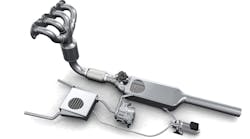One such company is Faurecia, founded in 1997 and now one of the largest international automotive parts manufacturers in the world. Recognized for its operational excellence and technological expertise, Faurecia is a preferred partner of the world’s largest automakers.
With 330 sites including 30 research and development centers in 34 countries around the world, Faurecia is a global manufacturing leader in automotive seating, interior systems, automotive exteriors, and emissions control technologies. The company is recognized as a pioneer in technological innovations—reducing the weight of vehicles, offering customized comfort and style solutions, and mitigating impact on the environment. At the same time, Faurecia is also developing new manufacturing processes that are set to revolutionize its production methods.
“At Faurecia, we work with some of the biggest original equipment manufacturers (OEMs) in the world,” says Rafael Unruh, competence center manager, Faurecia. “We are a pioneer in automotive technology and manufacturing processes. We pride ourselves on providing our customers with a superior product that keeps them coming back with each iteration of a vehicle.”
Traceability the challenge
While Faurecia has a long track record of providing its customers with exemplary products, the increasing need to provide customers traceability for the parts it was producing motivated the company to further support these efforts. The large automotive OEMs expect Faurecia to be able to both track the process of operations and production and to make that information available on demand. For example, customers wanted to know which airbags were added to which cars, as well as detailed data characteristics about how each airbag was installed, including torque and angle of installation.
Although the data for providing this traceability had always been available, the organization’s solutions for collecting and distributing it were not on par with the efficiency and scalability that can be achieved with today’s more modern IoT solutions and supporting architectures.
“In the modern age of manufacturing, data is king,” says Unruh. “Consumers today have come to expect that they can get an update on a process at any time without the need for human interaction or intervention, and the same is true for our customers. We realized that we needed to provide greater transparency into our processes and products, so that our customers can plan and react accordingly and improve their own efficiencies.”
From OPC DA to REST/HTTP
Realizing that connectivity, data access, and scalability would be essential, Faurecia set out to find a communication solution that could connect to the various programmable logic controllers (PLCs) on the factory floor. The company began a pilot program in its Porto Real, Brazil factory using Kepware’s flagship connectivity platform, KEPServerEX. The company was familiar with the solution, having used KEPServerEX for a number of years to connect PLCs on the plant floor to “IJ Core,” Faurecia’s proprietary parts fabrication and manufacturing execution system (MES) via the OPC DA protocol.
Using OPC DA to broker communications was complicated and becoming increasingly antiquated. The company considered replacing its OPC DA communications with OPC UA, which—though more modern—proved to be even more complex and required time and resources for implementation.
After learning more about Faurecia’s goals, Kepware representatives recommended that Faurecia implement the REST Server Agent in the IoT Gateway for KEPServerEX. The developers working on Faurecia’s MES were already comfortable with REST/HTTP (protocols ubiquitous in IT and on the web, and used in Internet of Things platforms) and were excited about the new middleware language that used KEPServerEX connections they already had in place.
“The IoT Gateway’s ease of implementation and use—and ability to communicate with the leading devices on the shop floor—gives us peace of mind,” says Unruh. “We’re able to concentrate on other facets of the business because it just works. With greater visibility into the processes we have in place, we’re able to make more educated decisions about our future, which is invaluable.”
Boardroom to shop-floor benefits
By implementing the IoT Gateway as the communications medium between PLCs on the plant floor and IJ Core, Faurecia is able to provide customers with the product traceability they require. With new visibility into the manufacturing data of parts provided by Faurecia, the world’s largest automotive OEMs are able to satisfy regulatory requirements and improve overall product quality for consumers.
Internal Faurecia stakeholders are benefiting as well. Operators on the machine floor note that communications are much faster, and the quality assurance department has the industrial data they need in order to analyze production quality. The solution has also improved the daily professional quality of life for developers working on IJ Core. Utilizing the familiar REST protocol instead of OPC DA enables them to spend more time increasing productivity and less time troubleshooting.
Furthermore, technology from Kepware is helping to bridge the gap between operations technology (OT) and information technology (IT) by enabling executives in Faurecia’s boardroom to access and leverage data to boost efficiencies across the organization.
Since implementing the IoT Gateway for KEPServerEX, Faurecia was able to decrease its transparency project from a complicated six-month scope to a functioning solution in just a couple of days. This has resulted in significant time and revenue savings—and satisfied customers. Given the ease of implementation and overall success of the Brazil pilot, Faurecia plans to standardize on KEPServerEX in its North American, Asian, and European factories in 2016.
The company is also interested in using the data to do more proactive analytics on the machines. Faurecia plans to serve production data to plant supervisors on a tablet display, allowing them to monitor and make real-time changes to production in order to reduce unplanned downtime and improve operations.
“We see huge potential with the IoT Gateway and are excited to deploy it across the 34 countries we operate in,” says Unruh. “We’re seeing benefits from this implementation from the boardroom to the shop floor, and only expect them to increase as more locations utilize it. We’re able to be smarter and more nimble in our decision-making, which leads to better products and services for our customers.”


